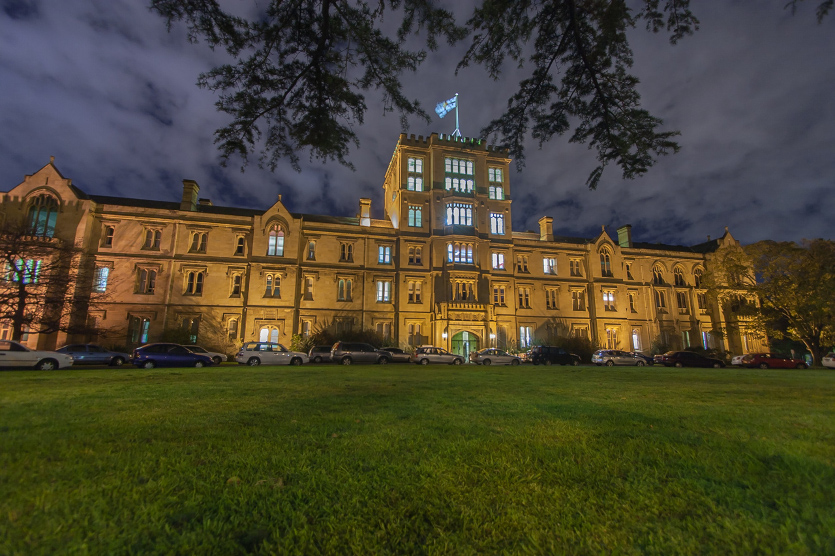Difference between revisions of "Queen's College"
(→Opening) |
(→Coat of Arms) |
||
| Line 10: | Line 10: | ||
== Coat of Arms == | == Coat of Arms == | ||
[[File:Queens-college-logo-crest.png]] | [[File:Queens-college-logo-crest.png]] | ||
| + | <br> | ||
| + | <br> | ||
| + | The College's coat of arms celebrates its founding as a Methodist institution, in the tradition of the 18th-century Anglican minister, John Wesley.[5] It has the following heraldic description: | ||
| + | |||
| + | :''Argent, a cross sable, in each quarter three escallops of the last, for Wesley; on an escutcheon of pretence the Royal Arms of England. Crest: on a wreath and sable, a wyvern proper. Motto: Aedificamus in aeternum.'' | ||
| + | |||
| + | The actual rendering of the eschutcheon uses not the arms of England, but the arms of the United Kingdom. This is superimposed on the arms of John Wesley. | ||
| + | |||
| + | The college motto translates to We build for eternity. | ||
| + | |||
| + | The arms were assumed without a formal grant from the College of Arms. | ||
== History == | == History == | ||
Revision as of 15:41, 13 March 2016
Contents
Introduction
Queen's College is a residential College affiliated with the University of Melbourne providing accommodation to 220 students who are attending the University of Melbourne, Victorian College of the Arts, RMIT University and Monash University Faculty of Pharmacy and Pharmaceutical Sciences.
In addition to the students, the Queen's College (affectionately known simply as "Queen's") also houses a number of fellows, resident tutors, scholars and professionals (collectively known as the Senior Common Room), staff, and academic guests.
Coat of Arms

The College's coat of arms celebrates its founding as a Methodist institution, in the tradition of the 18th-century Anglican minister, John Wesley.[5] It has the following heraldic description:
- Argent, a cross sable, in each quarter three escallops of the last, for Wesley; on an escutcheon of pretence the Royal Arms of England. Crest: on a wreath and sable, a wyvern proper. Motto: Aedificamus in aeternum.
The actual rendering of the eschutcheon uses not the arms of England, but the arms of the United Kingdom. This is superimposed on the arms of John Wesley.
The college motto translates to We build for eternity.
The arms were assumed without a formal grant from the College of Arms.
History
Founding
The college was founded in 1887, on 10 acres (40,000 m2) of land assigned to the Methodist Church by the Parliament of Victoria in the area then known as University Reserve (now College Crescent). While this land was allocated soon after the founding of the university in 1853, it was not until 1878—some twenty-five years later—that the Methodist Conference took the first steps towards building the college.
The then Governor of Victoria, Sir Henry Brougham Loch, laid the foundation stone on June 16, 1887 after the tireless efforts of Reverend William Abraham Quick, who is widely regarded as the founder of Queen's.
Naming
Initially, it was decided that the college was to be named Victoria College. However, when it became clear that it was to be built in the year of Queen Victoria's golden jubilee, it was finalised in December 1886: "That the new College be called Queen's College in honour of the Queen's Jubilee"
Opening
Queen's opened its doors on March 16, 1889 with a total of 24 students, under the leadership of Rev. Dr. Edward Holdsworth Sugden, who would go on to hold the position of The Master for over forty years. Shortly afterward, it became clear that more building was necessary, and on April 20, 1890, the South Wing was opened. Subsequent extensions were made in 1905, and in 1910 a new East Wing was created, joining the new southern wing with the original sections.
During this time (from 1897 to 1920), it is noted that "Queen's College was a veritable hothouse of dramatic activity", with plays and soirees being performed several times annually. Melbourne University Student Theatre traces its roots to this time, and it is no wonder that promotional posters from these productions still adorn the walls of the college to this day.
Expansion
Post-Great War pressures nurtured additional building plans, advocated mainly by J. T. Tweddle. The central tower (named the Sugden tower after the first master of the college, Rev. Edward J. Holdsworth Sugden) and a new northern wing, known as the Tweddle Wing, were constructed and completed in 1923. 1930 saw the introduction of a scientific laboratory (which now serves as a student recreation centre) in the southern section of the college, courtesy of A. M. and G. R. Nicholas.
From 1958 to 1978, a significant expansion and improvement programme was enacted, partly funded by the Commonwealth Government. The Raynor C. Johnson Wing, named after the college's third Master and erected in the west of the college grounds, was completed in two stages. The first opened in 1961, with the second following eight years later. During the construction of the Johnson Wing, it became clear that the dining hall (which now serves as the Junior Common Room) was too small to contain the projected student body. As such, the current Eakins Hall was built, finished in 1964. The final student accommodation building, Kernick House, was completed in 1975.
In 1964, 3 acres (12,000 m2) of college land was allocated for the creation of a women's college. The college, named St Hilda's is now a coeducational facility, as by the time it was completed Queen's was also accepting both men and women as equal members.
For a decade from 1969, Queen's had also been ensuring that the pre-existing facilities would attain the same standard as the new wing. The resulting "comfortable, single bedroom studies" remain much the same format today. Also around this time, the Methodist Church merged with most parishes of the Presbyterian Church to form the Uniting Church, of which the college thus became an institution.
Coinciding with the College's centenary celebrations, the new Featonby Library and several tutor flats contained in Parnaby Wing were opened in 1987. More recently, the college has focused on expanding accommodation for academic visitors, postgraduate students and resident tutors, with the construction of Scott Terrace(1998), Jack Clarke and Lapthorne buildings (2000). Queen's currently has future plans to extend student accommodation by 2012.
